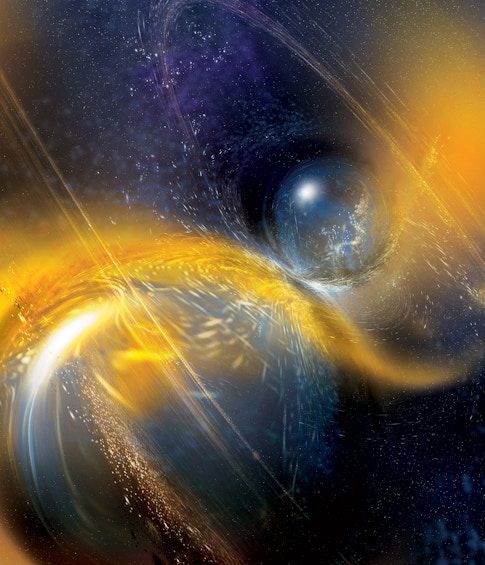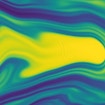LIGO-Virgo Network Catches Another Neutron Star Collision

On April 25, 2019, the gravitational-wave observatory network that includes the National Science Foundation’s LIGO and the European Virgo detectors picked up what appeared to be gravitational ripples from a collision of two neutron stars. Now, a new study confirms that this event, which was witnessed by only one detector in the network, LIGO Livingston, was indeed likely the result of a merger of two neutron stars. This would be only the second time this type of detection has ever been made.
The first such detection, which took place in August of 2017, made history for being the first time that both gravitational waves and light were detected from the same cosmic event. The April 25 merger, by contrast, did not result in any light being detected. However, through an analysis of the gravitational-wave data alone, researchers have learned that the cosmic collision resulted in a merged object with an unusually high mass.
“From conventional observations with light, we already know of 17 binary neutron star systems in our own galaxy and we have estimated the masses of these stars,” says Ben Farr, a LIGO team member based at the University of Oregon. “What’s surprising is that the combined mass of this binary is much higher than what was expected.”
“Heavy neutron stars have been observed before but always with other objects that were not neutron stars,” says Will Farr, group leader for gravitational wave astronomy at the Flatiron Institute’s Center for Computations Astrophysics in New York City. “The fact that heavy neutron stars form binaries and subsequently merge gives us hope that we can study the most extreme conditions imaginable with gravitational waves.”
“We have detected a second event consistent with a binary neutron star system and this is an important confirmation of the August 2017 event that marked an exciting new beginning for multi-messenger astronomy two years ago,” says Jo van den Brand, Virgo Spokesperson and professor at Maastricht University, and Nikhef and VU University Amsterdam in the Netherlands. Multi-messenger astronomy occurs when different types of signals are witnessed simultaneously, such as those based on gravitational waves and light.
The study, submitted to the Astrophysical Journal Letters, is authored by an international team that comprises the LIGO Scientific Collaboration and the Virgo Collaboration, the latter of which is associated with the Virgo gravitational-wave detector in Italy. The results were presented yesterday, January 5, at the 235th meeting of the American Astronomical Society in Honolulu, Hawaii.
Neutron stars are the remnants of dead stars that exploded. When two neutron stars spiral together, they undergo a violent merger that sends gravitational shudders through the fabric of space and time.
LIGO, which stands for the Laser Interferometer Gravitational-Wave Observatory, became the first observatory to directly detect gravitational waves in 2015; in that instance, the waves were generated by the fierce collision of two black holes. Since then, LIGO and Virgo have registered dozens of additional candidate black hole mergers.
The project’s first detection of a neutron star merger took place in August of 2017: both LIGO detectors, one in Livingston, Louisiana, and one in Hanford, Washington, detected the event, together with a host of light-based telescopes around the world (neutron star collisions produce light, while black hole collisions are generally thought not to do so). This merger was not clearly visible in the Virgo data, but that fact provided key information to ultimately pinpoint the event’s location in the sky.
In the case of the April 2019 event, only a single detector in the LIGO-Virgo network picked up the gravitational-wave signal—LIGO Livingston. The LIGO Hanford detector was temporarily offline, and, at a distance of more than 500 million light-years, the event was too faint to be detected with Virgo’s current sensitivity, in addition to being located in a region of sky where Virgo is less sensitive. Using the Livingston data, combined with information derived from Virgo’s observations, the team narrowed the location of the event to a patch of sky more than 8,200 square degrees in size, or about 20 percent of the sky. For comparison, the August 2017 event was narrowed to a region of just 16 square degrees, or 0.04 percent of the sky.
“This is our first published event for a single-observatory detection,” says Caltech’s Anamaria Effler, a scientist who works at LIGO Livingston Observatory. “But Virgo made a valuable contribution. We used information about its non-detection to tell us roughly where the signal must have originated from.”
The LIGO data reveal that the combined mass of the merged bodies is about 3.4 times that of the mass of our sun. Typically, in our galaxy, neutron star collisions are known to produce final masses of up to only 2.9 times that of sun. One possibility for the unusually high mass is that the collision took place not between two neutron stars, but a neutron star and a black hole, since black holes are heavier than neutron stars. But if this were the case, the black hole would have to be exceptionally small for its class. Instead, the scientists believe it is more likely that LIGO witnessed a shattering of two neutron stars, and that their merger resulted in a newly formed black hole of about 3.4 solar masses.
“What we know from the data are the masses, and the individual masses most likely correspond to neutron stars. However, as a binary neutron star system, the total mass is much higher than any of the other known galactic neutron star binaries,” says Surabhi Sachdev, a LIGO team member based at Penn State. “And this could have interesting implications for how the pair originally formed.”
Neutron star pairs are thought to form either early in life, when companion massive stars successively die one by one—or they are thought to come together later in life within dense, busy environments. The LIGO data for the April 25 event do not indicate which of these scenarios is more likely, but they do suggest that more data and new models are needed to explain the unexpectedly high mass.
The unexpectedly high masses are enticing for researchers investigating the extreme conditions inside neutron stars. The cores of the dense objects harbor matter with densities higher than those encountered in the nuclei of atoms that make up everyday matter. Theoretical calculations and laboratory experiments on earth cannot reach such extreme conditions, but astrophysical environments provide a natural laboratory.
“More massive neutron stars, such as the ones that we observed colliding on April 25, reach higher densities in their cores,” says Katerina Chatziioannou, a research fellow at the Center for Computational Astrophysics and co-chair of the extreme matter group of the LIGO Scientific Collaboration. “The gravitational wave signals they emit can carry information about densities as high as six times the density of atom nuclei.”
The extreme matter group analyzed the gravitational wave data to extract information about neutron star matter. “Unfortunately, this signal was too distant and too weak to provide definitive results. The effect of neutron star matter on gravitational waves is very subtle and requires a strong signal observed by multiple detectors. But the detectors will keep getting better and better, and they will keep looking for these heavy neutron star signals that we now know exist,” says Chatziioannou.
Media Contacts
Flatiron Institute
[email protected]
Caltech
Whitney Clavin
[email protected]
MIT
Abigail Abazorius
[email protected]
617-253-2709
Virgo
Livia Conti
[email protected]
NSF
Josh Chamot
[email protected]
703-292-4489


